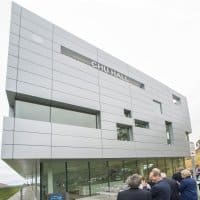The USA’s leading solar research laboratory has unveiled a new $59 million center at the University of California dedicated to the study of solar energy and the production of solar fuels.
The Solar Energy Research Centre (SERC) was officially opened after a ribbon-cutting ceremony at the U.S. Department of Energy’s Lawrence Berkeley National Laboratory. The center was named Chu Hall, after Steven Chu, former Director of Berkeley Lab and the U.S. Energy Secretary who spearheaded President Obama’s Sunshot Initiative.
“Steve’s commitment to ground-breaking science is really one of the reasons we’re naming this building after him,” said Berkeley Lab Director Paul Alivisatos. “We felt that his service to our lab, and to the country as Energy Secretary, could best be acknowledged by today’s naming.”
The three-story, 44,000-square-foot SERC building will house laboratories and offices of the Joint Center for Artificial Photosynthesis (JCAP), the nation’s largest research program dedicated developing low-cost artificial solar-fuel generation technology.
“JCAP’s current mission is to demonstrate a scalable, sustainable device that can generate fuels from sunlight and air at least 10 times more efficiently than plants,” says Berkeley Lab’s JCAP head, Frances Houle.
Previously, the 100 JCAP research staff was spread across leased space on the UC California campus. The joint venture between California Institute of Technology and Berkeley Lab scientists was renewed for five years with a $75 million grant from the DOE.
Chu Hall will also provide space for the Kavli Energy NanoSciences Institute (Kavli ENSI), a research program investigating the basic science of how to capture and channel energy using nanotechnology.
“We believe the opening of this building will provide a significant boost to solar fuels research,” said Alivisatos. “It puts our researchers, from various disciplines, together in a single space, close to UC Berkeley and Berkeley Lab colleagues studying similar challenges.”
Designed with an emphasis on innovation, the SERC building features specialised low-vibration rooms and state-of-the-art, modular laboratories that can be adapted to new discoveries in solar technology.
Founded in 1931, Berkeley Lab’s efforts have seen the organisation recognized with 13 Nobel prizes. Berkeley Lab employs approximately 3,232 scientists, engineers and support staff and overall economic impact of the facility on the US economy is estimated at $1.6 billion a year.














































